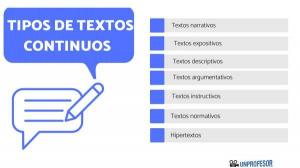Tips for making an INSTRUCTIVE text

It has always been explained to us that there are a good number of textual typologies that are based on different premises and whose purposes differ from each other. With this, we find texts that are more based on convincing, others prefer to present ideas objectively, etc. Among them we find the instructive texts. These texts have their own nature, structure and purposes.
In fact, it is a very common type of text, which we have all had in front of quite a few times and which is very useful for the reader or receiver. To learn more about these instructional texts, in a teacher we will discover how to make an instructional text knowing what it is and its characteristics general. Can you come with us?
Before telling you how to make an instructive text, we are going to know better what type of text it is. As the name suggests, an instructional text takes care of instruct the recipient on a specific topic. We do not necessarily have to talk about a written text, but it can also be given orally. Therefore, its main objectives are to direct the actions or movements of the receiver in order to help him / her perform a task effectively.
The language must be concise, simple and clear, since these instructional texts are not usually directed to a specific audience that understands about a specific topic, but rather focuses more on something more general. That is why, on many occasions, to illustrate the actions or components of a specific object they can be accompanied by graphics, illustrations, photos or descriptive texts.
In short, any instruction manual, warnings, regulations of any institution, YouTube tutorial, recipe or even instructions that can be given to any form on any subject, written or orally, would be found within what we know as text instructive.

If you want to know how to make an instructional text, keep these tips in mind that we give you below. By following them to the letter, you can make a good instructional text that is easy for everyone to understand.
Use connectors
To join the steps and ideas, the use of connectors is very useful. Among them we can use connectors such as: first, second, first, then, then, finally, last, etc.
Coexistence with descriptive texts
As we will see later, instructional texts are usually accompanied by visual aids. But on many occasions the use of a descriptive text for, as the name suggests, describe a component, for example, from an instruction manual for assembling a piece of furniture. For this reason, this type of text is usually used within the instructions to illustrate to the receiver what the manual refers to with certain technicalities.
Concise and simple language
Although technicalities may be found on the subject in which you are training, the text will be read by all types of users, no matter what previous knowledge they may have on the subject of the text. Therefore, there is no room for misinterpretations, imprecise language or misleading. In short, the language used must be precise, direct and concrete, without ramblings or overly technical or elaborate languages, whose function of the main language is appellative or conative.
Organization
The structure it is essential in instructional texts. For example, in a recipe it is expected that first the necessary ingredients and their quantities are listed, which are then expose the steps to follow for the realization of the recipe and that finally, on occasions, a certain presentation. In addition, they are usually accompanied by graphic examples such as photos.
Therefore, since it is a text aimed at a very general audience with a specific message and language, it is convenient that these instructions, tutorials or manuals come divided into several sections (with their corresponding and necessary subsections) and with the use of hyphens, enumerations or points for the exposition of components or important steps. For instance:
Ingredients:
-500 grams of flour
-Two glasses of oil
-1 clove garlic
-2 handfuls of salt
-3 liters of water
Steps:
1. Heat the oil
2. Frying unpeeled garlic
3. Take out the garlic
4. Add the flour and pour water little by little
5. Add the garlic and salt again
6. Stir until compact
Use of images
To make an instructive text, it is very common, as we said, the appearance of visual support as a images, graphs, photographs, diagrams or drawings of the elements that are presented in the instructions. For example, the graphic result as proof of the steps of a recipe for making a cake in its different stages.
Use of the imperative, infinitive and plural
The verbs used, being actions that the user must perform, usually appear in imperative. However, it is true that, in order to give a certain impersonality to the text, on many occasions we find instructive texts with verbs in infinitive or the first person plural (either in the form of past, present, future or some relevant conjugation depending on what you want express).
- Now that the two pieces are already fitted join them and fix them using the corresponding screw.
- The next step would be clean up the leftovers and leave it dry off.
- Now will follow with the next step, in which we will paint the vase.


